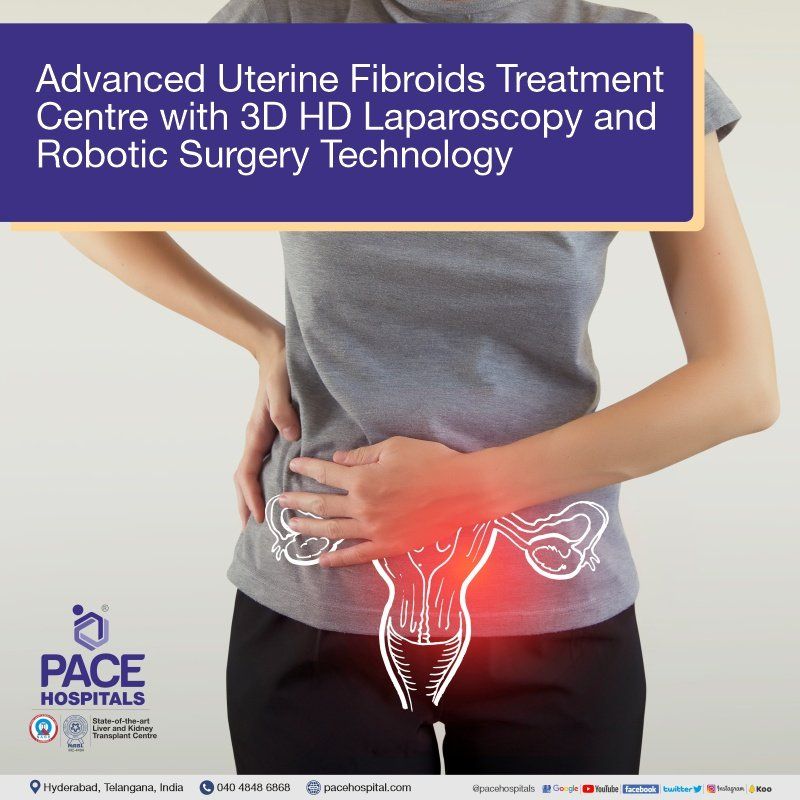Uterine Fibroids Treatment in Hyderabad | Surgery and Cost
At PACE Hospitals, team of uterine fibroid specialist - Laparoscopic and Robotic Gynaecologist, Interventional radiologists and surgeons are experienced in handling even the most complicated cases of uterine fibroids, and expertise in performing uterine fibroid removal surgery with using advanced laparoscopic and robotic surgery techniques with minimal time and high success rate. The treatment options available are:
- Uterine artery embolization
- Radiofrequency ablation
- Hysteroscopic myomectomy
- Laparoscopic or robotic myomectomy
- Endometrial ablation
- Abdominal myomectomy
- Total Laparoscopic or robotic hysterectomy
Get Rid of Uterine Fibroids. Request an appointment.
Uterine Fibroids Treatment - appointment
Thank you for contacting us. We will get back to you as soon as possible. Kindly save these contact details in your contacts to receive calls and messages:-
Appointment Desk: 04048486868
Whatsapp: 7842171717
Regards,
Pace Hospitals
Hitech City and Madinaguda
Hyderabad, Telangana, India.
Thank you for contacting us. We will get back to you as soon as possible. Kindly save these contact details in your contacts to receive calls and messages:-
Appointment Desk: 04048486868
Whatsapp: 7842171717
Regards,
Pace Hospitals
Hitech City and Madinaguda
Hyderabad, Telangana, India.
- Why choose us -
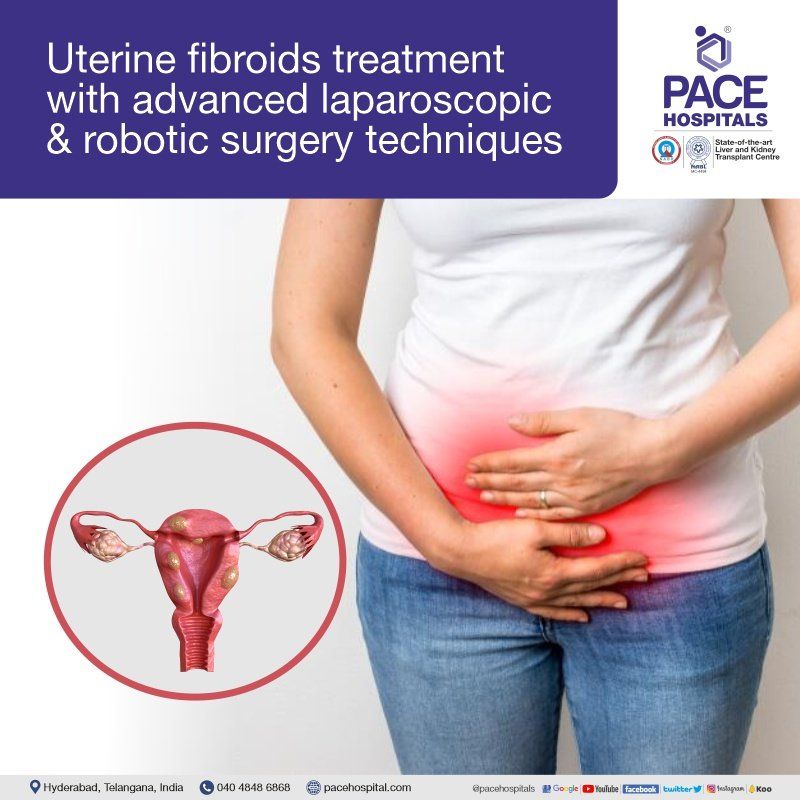
5000+ Robotic and Laparoscopic surgery for fibroids
Robotic Surgery Techniques for Precision Treatment with 99.9% success rate
Team of the Best Uterine Fibroids Doctors with 30+ years of expertise
All insurance accepted with No-cost EMI option
Uterine fibroids diagnosis
During a normal pelvic exam, fibroids may be detected for the first time. Nevertheless, there are several tests which could accurately reveal further details of the fibroids:
- Ultrasound abdomen and pelvis (USG): With the aid of sound waves, the uterus and other pelvic organs can be visualized during an ultrasound examination.
- Hysteroscopy: A narrow instrument called a hysteroscope is used during hysteroscopy to view the inside of uterus. Through the cervix and vagina, it is inserted (opening of the uterus). This enables your medical practitioner to see uterine fibroid growths.
- Hysterosalpingography (HSG): X-rays are used specifically for hysterosalpingography. The uterus and fallopian tubes' size and form could undergo aberrant modifications.
- Sonohysterography: This procedure involves injecting fluid via the cervix into the uterus. After that, ultrasound is utilised to reveal the uterus' inside. The fluid gives an accurate representation of the uterine lining.
- Laparoscopy: A thin instrument called a laparoscope is used during laparoscopy to allow your doctor to see into your abdomen. It is inserted through or just below the belly button through a tiny cut. The laparoscope can be used to see fibroids that are external to the uterus.
- Blood tests: The doctor may prescribe additional tests to rule out other possible causes of abnormal menstrual bleeding, such as a complete blood count (CBC) to check for the possibility of anaemia due to persistent blood loss and other blood tests to rule out bleeding disorders.
However, there are imaging tests such as computed tomography (CT) and magnetic resonance imaging (MRI) scans which could be useful in some cases to monitor the development of fibroids over time.
With a sensitivity of 88% to 93%, MRI is one of the most reliable methods for diagnosing fibroids and distinguishing them from focal adenomyosis. As MRI does not utilize ionizing radiation it therefore can clearly show the uterine zonal structure, it is more sensitive than ultrasound at detecting uterine fibroids. With MRI, fibroids as tiny as 5 mm in diameter can be visualized, and submucosal, intramural, and subserosal fibroids are typically clearly distinguished from one another. Through MRI the fibroids which occur at relatively uncommon places, such the cervix also can be detected.
The key criteria in evaluating the fibroids primarily include the presenting symptoms of the patient, such as abnormal menstrual flow, mass symptoms, pelvic pain, or anaemia-related abnormalities.
- During a normal pelvic exam or by chance during imaging, fibroids are occasionally discovered in asymptomatic women (women in whom symptoms of fibroids are not seen).
- Ultrasonography is usually the preferred imaging method of choice for fibroids.
- The uterine fibroids can be detected with the transvaginal ultrasonography (An ultrasound probe is inserted around two to three inches into the vaginal canal during this procedure by your doctor or a technician to examine female reproductive organs), which has a 90% to 99% sensitivity range, however it can miss subserosa or tiny fibroids.
- Hysteroscopy or sonohysterography can increase the sensitivity of a test for submucosal myomas.
Advanced Uterine Fibroids Treatment Centre with 3D HD Laparoscopy and Robotic Surgery Technology
PACE Hospitals is one of the Advanced Uterine Fibroids Treatment Hospital in Hyderabad backed up with team of uterine fibroid specialist - Gynaecologists and Obstetricians, surgeons, nursing, and paramedical staff. Obstetrics and gynaecology department at Pace Hospitals equipped with state-of-the-art facility, latest robotic surgery system and 3D HD laparoscopic equipments comprehensive treatment for Submucosal fibroids, Intramural fibroids, Subserosal fibroids, Intracavitary fibroids, Cervical fibroids and Pedunculated fibroids.
Uterine Fibroids Treatment
In most cases, the treatment is not necessary if the symptoms are mild. Medications are mostly used to treat symptoms caused due to uterine fibroids, like abdominal pain and bleeding.
Medical Treatment
- Nonsteroidal anti-inflammatory drugs (NSAIDs) such as ibuprofen and antifibrinolytics such as tranexamic acid can be given to treat uterine fibroids' symptoms effectively. Nevertheless, the NSAIDs can’t be given to decrease the size of the fibroids.
- Gonadotropin releasing hormone agonists (GnRHa) medications can be given as an implant, nasal spray, or injection to shrink the uterine fibroids. These drugs work by stopping the production of oestrogen and progesterone. However, these drugs offer only temporary relief, as the uterine fibroids start to grow back quickly once the regimen is stopped.
- Vitamin and iron supplements may be prescribed by your doctor to treat heavy menstrual bleeding (Menorrhagia) and anaemia.
- Progestin-releasing intrauterine device (IUD): An IUD that releases progesterone can stop excessive bleeding brought on by uterine fibroids. A progestin-releasing IUD merely relieves symptoms; it does not reduce or eliminate fibroids. It also avoids getting pregnant.
However, there are no medications available for dissolving or totally suppressing the fibroids. All the medications in the form of tablets, capsules, injections and implants are only prescribed in case the patients want to postpone the surgery. If the symptoms of fibroids are significant, then surgery could be the best way to treat them.
Surgical Treatment
Depending on the diagnosis and severity, there are uterine fibroids surgery options available which can be suggested for the uterine fibroids treatment.
Traditional surgeries, such as
Abdominal
Myomectomy and Hysterectomy
were performed for very large fibroids, multiple fibroids, very deep fibroids, or permanent solution for uterine fibroids have been outdated and replaced by minimally invasive techniques that use laparoscopy or robotic surgical system to perform uterine fibroid removal surgery, such as:

Radiofrequency Ablation
Radiofrequency ablation is a safe, dependable, and effective procedure. It is minimally invasive treatment option which is effective for women with recently developed fibroids, apart from preserving the uterus. High temperatures are used in radiofrequency ablation to kill tissue. In the case of large fibroids. Laparoscopically uterine fibroids navigated, further targeted with radiofrequency heat due to which fibroids are reabsorbed by the myometrium (tissue lining the uterus) while the overall myometrium as well as the ovum remain unharmed.
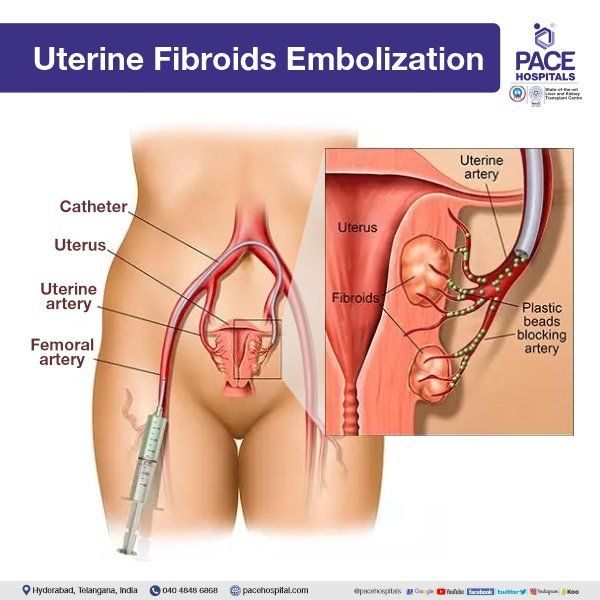
Uterine Fibroid Embolization (UFE)
In patients who intend to keep their uterus or refrain from surgery due to medical comorbidities or personal preference can choose
uterine artery embolization. The procedure includes administration of drugs which cut off the blood supply are injected into one or both uterine arteries during an interventional radiologic treatment to stop the blood circulation to the uterus and fibroids. Although uterine artery embolization has a considerably shorter hospital stay than hysterectomy and myomectomy, and a lower chance of needing a blood transfusion, it is contraindicated in pregnancy, uterine infections.

Laparoscopic myomectomy
It is an option, especially for women who plan to have children in the future. In this surgery, the uterus is left intact after the removal of the fibroids. However, it's not feasible in all the cases. In between 80-90% of the cases, myomectomy patients have either symptom alleviation or symptom reduction. Although, the fibroids won't recur after surgery, there are chances for the development of new fibroids. Due to the growth of additional fibroids, up to 33% of women who undergo this surgery will require a second operation within 5 years.
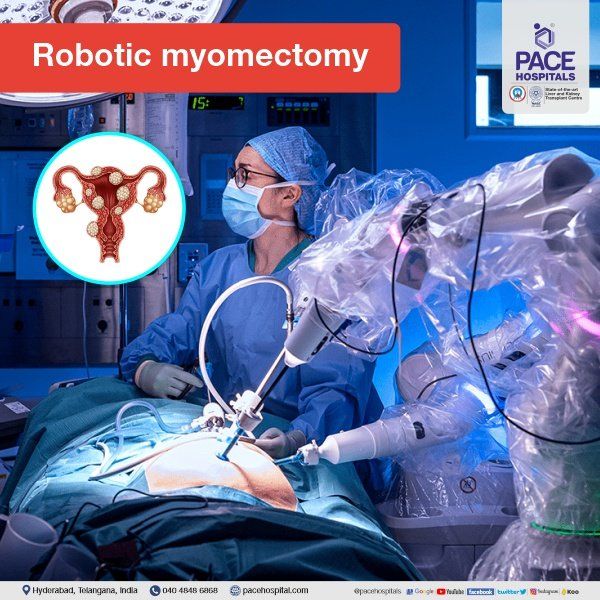
Robotic myomectomy
It is a kind of laparoscopic myomectomy. In comparison to open surgery, a robotic myomectomy may result in less blood loss, fewer problems, a shorter hospital stay, and a quicker return to normal activities. Traditional laparoscopy and robotic surgery may take longer and cost more, but overall outcomes are typically similar.
In case of giant fibroids and sub-mucosal fibroids open myomectomy and hysteric myomectomy is done respectively.
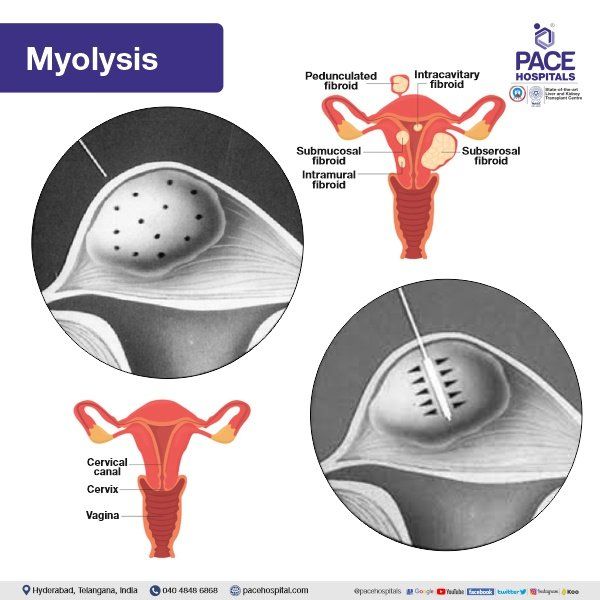
Myolysis
With the help of a focused energy delivery system, such as heat, laser, or more recently, magnetic resonance-guided focused ultrasound surgery (MRgFUS), fibroids can be destroyed in a minimally invasive treatment called myolysis.

Endometrial ablation
In endometrial ablation, the inner lining of the uterus is removed through a variety of techniques, such as microwave heating, laser radiation, or a heated wire loop. This surgery is typically advised for fibroids that are near to the uterus' inner lining.
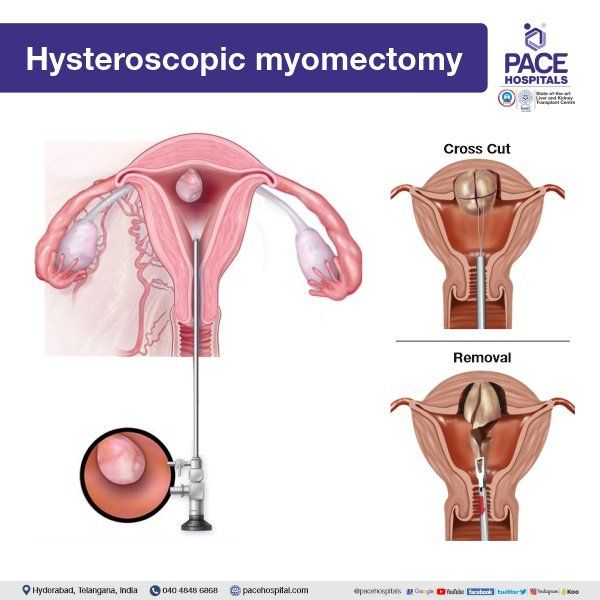
Hysteroscopic myomectomy
This procedure is best suited for the surgical treatment of intracavitary fibroids (the fibroids which grow into the uterus also called submucosal fibroids). Hysteroscopy allows surgeons to selectively remove intrauterine pathological conditions, and hysteroscopic myomectomy, a single surgical operation, has steadily evolved into a safe and efficient treatment over the years. Usually there is no need for any incisions on the body (so no scars) and patients can expect very minimal hospital stay. The recovery time is generally only a few days. In submucosal fibroids, hysteroscopic myomectomy enhances pregnancy chances.
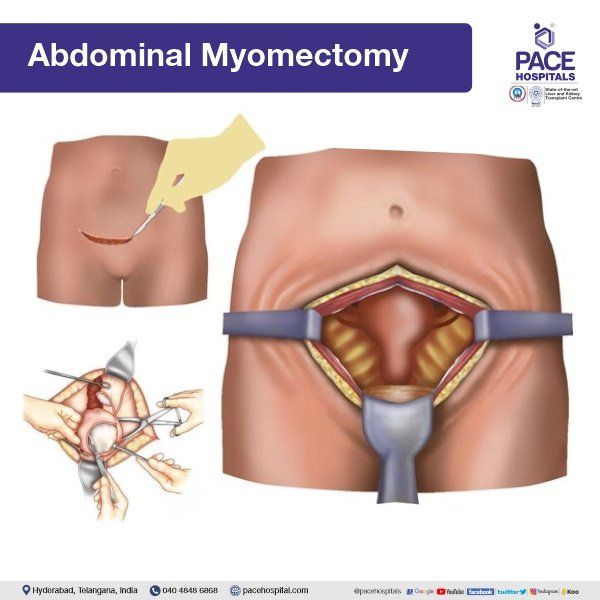
Abdominal Myomectomy or Laparotomy
An abdominal myomectomy, also referred to as an "open" myomectomy, is a significant surgical treatment. It entails removing the fibroids from the uterine wall using a "bikini cut" incision made through the skin on the lower abdomen. After that, multiple layers of stitches are used to reconstruct the uterine muscle. This procedure will be performed when the patient is under anaesthesia. A blood transfusion can be necessary due to bleeding during the procedure. Most women stay in the hospital for two nights before returning home to recover for four to six weeks.
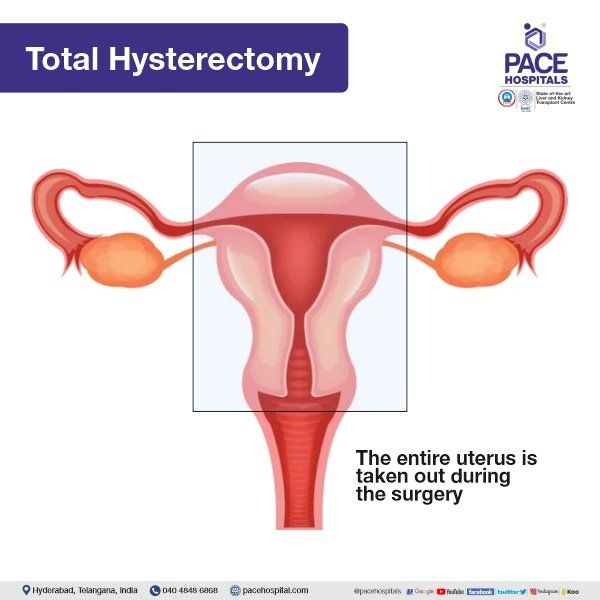
Total Laparoscopic hysterectomy or Total robotic hysterectomy
The most conventional and frequent therapy for fibroids is total laparoscopic hysterectomy or total robotic hysterectomy or total abdominal hysterectomy where the entire uterus is taken out during the surgery and so it is usually done in patients who had children.
In comparison to laparoscopic hysterectomy, a robotic hysterectomy may result in less blood loss, a shorter hospital stay, and a quicker return to normal activities.
-
Is uterine fibroid a serious problem?
Although uterine fibroids are not cancerous and have very little chances of developing into a cancerous growth, at times, it can be difficult to distinguish if the uterine mass is a common fibroid or a cancerous tumour.
The size of the fibroids can be as small as a pea to as large as a melon. Although uterine fibroids are typically not harmful, they can be uncomfortable and can sometimes result in issues, such as a decline in red blood cells (anaemia), which results in exhaustion due to significant blood loss. Rarely does blood loss necessitate a transfusion.
-
Do uterine fibroids affect fertility?
Yes, uterine fibroids can affect fertility. Especially, sub-mucosal and intramural fibroids can affect the implantation of embryo.
-
What causes uterine fibroids to grow after menopause?
Usually, regression of uterine fibroids is seen during the menopause phase accounting for the lack of oestrogen stimulation. However, it has been suggested that various factors can at times stimulate the growth of uterine fibroids in the postmenopausal age group (menopause has been absent for more than one year, on average 48 years of age in Indian women). This is more pronounced in obese postmenopausal women.
-
Which is the best mode of surgery for fibroid?
Once diagnosed the patient and the doctor needs to discuss the next advancement as the treatment and surgery of fibroids vary greatly with patients basing mainly upon the risks the surgery poses and the patient's choice to have or not to have biological children. Nevertheless, on the whole, laparoscopic and robotic surgeries are usually considered safe and effective when compared with traditional surgeries.
Frequently asked questions:
What are the symptoms of uterine fibroid?
Uterine fibroid symptoms are not seen in most of the patients but in 30% have abnormal uterine bleeding (may cause pain and anaemia) and pelvic pressure or pain. Usually, the larger the fibroid, the more likely the symptoms appear. The other common symptoms are:
- A sense of "fullness" in the lower abdomen
- Increase in the frequency of urination
- Painful intercourse
- Internal menstrual bleeding
- Lower back pain
- Reproductive problems, such as infertility, multiple miscarriages or early labour
- Difficulty in conception
Can uterine fibroids cause no period?
Uterine fibroids can cause abnormal periods or secondary amenorrhoea (the absence of three or more periods in a row by a person, earlier, who has had periods).
Should I worry with uterine fibroid?
You may need to be alert if:
- You are an ageing woman, especially during the 30s and 40s or going through menopause. After menopause, fibroids gradually shrink.
- You experienced menarche earlier than the average
- You have excessive amount of oestrogen activity in the body (hyperestrogenism)
- You have a mother who had fibrosis; you are thrice more likely to contract fibroids than the average.
- You are from African-American ethnicity.
- You are obese, as the risk for very heavy women is doubled or tripled than the average.
- You are consuming a lot of red meat.
Why do uterine fibroids occur?
Despite research, doctors are unsure of the cause of fibroids. Nevertheless, it is evidenced that the two feminine hormones - progesterone and oestrogen, could be able to enlarge the fibroids. Because of the increased hormone levels that occur during pregnancy, fibroids frequently get bigger. When hormone levels are low after menopause, fibroids cease developing and may even shrink.
Why should I do so many medical tests before surgery?
Before surgery the doctors need to assess the function of lungs, heart, kidney and other organs to rule out the possibilities of any other medical diseases so that anaesthesia and surgery can be planned accordingly and prevent complications during and after the procedure.
Do uterine fibroids burst?
Majorly uterine fibroids are not life-threatening, but there are cases of fibroid burst/rupture due to a plethora or reasons such as
- an injury,
- a twisted fibroid,
- a fibroid that has grown too large for its blood supply, or
- an increase in blood pressure or abdominal pressure,
Increased blood pressure or acute blood loss are serious complications of a ruptured uterine fibroid. If you experience severe abdominal pain or suspect you have a burst fibroid, see a doctor immediately.
What size uterine fibroid is considered large?
A size of 4 cm or more is considered as a large fibroid in the uterine muscle which can potentially affect implantation. Infertility can result from fibroids that restrict the fallopian tubes inside the uterine muscle. Sometimes fibroids can have an impact on the delivery of a baby.
Which size of uterine fibroid is dangerous?
Large uterine fibroids which are about 4 cm or more are dangerous for women it can cause abnormal uterine bleeding (AUB), infertility (not getting pregnant), thromboembolism, acute urinary retention, female reproductive organs' distortion etc.
Uterine fibroids which are about 4 cm or more developing inside the uterus, can block fallopian tubes. In case of fibroids growing outside the uterus, they could reach to pleura (chest lining), pressurise and thereby cause pain. Complications in pregnancy could also arise.
What happens when a uterine fibroid patient is conceived, and she was not aware of it at the time of conception?
In case if it is a serosal fibroid it poses no harm for the foetus. In case if it is a intramural/submucosal fibroid, the patient may be presented with intermittent bleeding during pregnancy. At times abruption (breakage of placenta from the wall of the uterus) and/or abortion (termination of the pregnancy all together) can occur in 2nd trimester (4th to 6th months of pregnancy).
What is the best way for the early detection of uterine fibroids?
Every woman must undergo routine annual gynaecological checkups, basic ultrasound examination and pap smear test. Through these regular gynaecological checkups, not only the uterine fibroid, but other anomalies can also be detected citing prompt actions by the healthcare team.
How much time will be the stay in hospital for laparoscopic myomectomy?
The hospitalization stay depends upon the size of fibroid:
- In case of small 2 medium-sized myoma fibroid - A simple day care procedure
- In case of large and giant fibroids - 2 to 3 days of hospital stay
Can I do my regular activity and join work after my surgery after laparoscopic myomectomy?
You need rest of at least 5-10 days before you can resume your routine. Simultaneoulsy consult your doctor to have better understanding of the rest since it varies patient to patient and depends upon the health condition and medication advised.
Which is the best mode of surgery for uterine fibroids?
Once diagnosed, the patient and the
gynaecologist need to discuss the next advancement as the medical treatment and surgery of uterine fibroids vary greatly with patients basing mainly upon the risks the surgery poses and the patients‘ choice to have or not to have biological children. Nevertheless, on the whole, laparoscopic and robotic surgeries are usually considered as safe and effective when compared with the traditional surgeries.
Can I take normal diet after my surgery for uterine fibroids?
Yes, many patients start taking normal diet from day 2 of surgery. Consulting with a primary doctor will help in choosing the type of diet and precautions after surgery.
Why is open surgery not advised when compared with laparoscopic myomectomy?
In comparison to open myomectomy, laparoscopic myomectomy has a number of advantages for patients, including minimal blood loss during surgery, quick postoperative recovery, and a shorter hospital stay. It has received a lot of attention as a potential replacement for the standard laparotomy throughout the past few decades. The other influencing factors include:
- No need to rest for 3 months
- No big scar on abdomen
- No need of blood transfusions
- No need of heavy antibiotic use
- Lesser pain and discomfort
- Lesser painkillers
- Lesser chances of wound infection and hernia
What are the complications of the uterine artery embolisation?
These are some of the complications related to uterine artery embolisation:
- Unusual bleeding (haemorrhage) uterine injury
- Infection of the uterus
- Hematoma or a collection of blood under the skin, at the puncture site
- Injury to the artery being used
- Blood clots
- Infertility
How much does uterine fibroid surgery cost in Hyderabad?
Uterine fibroid surgery cost in Hyderabad ranges vary from Rs. 48,000 to Rs. 4,50,000 (forty eight thousand to four lakh fifty thousand). However, cost of uterine fibroid removal surgery depends upon the multiple factors such as the age of the patient, technique used for fibroids removal (such as uterine fibroids embolization, hysteroscopic myomectomy, radiofrequency ablation, endometrial ablation, laparoscopic or robotic myomectomy, laparoscopic or robotic hysterectomy), the size, number and type of fibroids, risks associated with the surgery, selection of room for hospital stay, CGHS, EHS, ESI, insurance or corporate approvals for cashless facility.
How much does uterine fibroid surgery cost in India?
Uterine fibroid surgery cost in India start from Rs. 55,000 and go up to to Rs. 5,25,000 (fifty-five thousand to five lakh twenty-five thousand). However, cost of uterine fibroid removal surgery in India depends upon the multiple factors such as the patient's age, technique used (such as uterine fibroids embolization - UFE, radiofrequency ablation - RFA, hysteroscopic myomectomy, laparoscopic or robotic myomectomy, endometrial ablation, laparoscopic or robotic hysterectomy), the number, size, and fibroids type, complications associated with the procedure, room selection for stay in hospital, corporates, EHS, CGHS, ESI, or insurance approvals for cashless facility.
Are uterine fibroids treatment covered by insurance in Hyderabad?
Yes, in Hyderabad uterine fibroids treatment are covered by insurance, TPAs, CGHS etc. Person need to cross-check with their respective health insurance companies and corporates about the partial or complete eligibility to get the benefits.
Is fibroid removal covered by insurance in India?
Yes, all insurances cover uterine fibroid removal surgery in India. If you are planning for surgery check with your insurance provider about the benefits and coverage because this completely depends upon the policy selection during purchase.
Our Locations
Subscribe to our newsletter and stay updated with the latest health information.
By clicking on subscribe now, you accept to receive communications from PACE Hospitals on email, SMS and Whatsapp.
Subscribe to PACE Hospitals News
Thank you for subscribing. Stay updated with the latest health information.
Oops, there was an error. Please try again submitting your details.
-

Payment in advance for treatment (Pay in Indian Rupees)
For Bank Transfer:-
Bank Name: HDFC
Company Name: Pace Hospitals
A/c No.50200028705218
IFSC Code: HDFC0000545
Bank Name: STATE BANK OF INDIA
Company Name: Pace Hospitals
A/c No.62206858997
IFSC Code: SBIN0020299
Scan QR Code by Any Payment App (GPay, Paytm, Phonepe, BHIM, Bank Apps, Amazon, Airtel, Truecaller, Idea, Whatsapp etc)
Call us at 04048486868
ADDRESS
PACE Hospitals
Hitech City : Beside Avasa Hotel, Pillar No. 18, Hyderabad - 500081
Madinaguda: Mythri Nagar, Beside South India Shopping, Madinaguda, Hyderabad - 500050
QUICK LINKS
Disclaimer
General information on healthcare issues is made available by PACE Hospitals through this website (www.pacehospital.com), as well as its other websites and branded social media pages. The text, videos, illustrations, photographs, quoted information, and other materials found on these websites (here by collectively referred to as "Content") are offered for informational purposes only and is neither exhaustive nor complete. Prior to forming a decision in regard to your health, consult your doctor or any another healthcare professional. PACE Hospitals does not have an obligation to update or modify the "Content" or to explain or resolve any inconsistencies therein.
The "Content" from the website of PACE Hospitals or from its branded social media pages might include any adult explicit "Content" which is deemed exclusively medical or health-related and not otherwise. Publishing material or making references to specific sources, such as to any particular therapies, goods, drugs, practises, doctors, nurses, other healthcare professionals, diagnoses or procedures is done purely for informational purposes and does not reflect any endorsement by PACE Hospitals as such.

